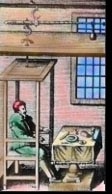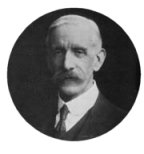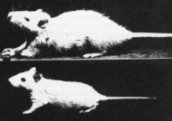|
Frederick Gowland Hopkins (1861-1947) By 1901, Hopkins had devised new experimental methods to isolate uric acid (thought to be related to protein breakdown). Subsequent experiments showed how to make pure (crystalline) preparations of this compound. In France, physiologist Francois Magendie (mentor to experimentalist Claude Bernard) had already demonstrated that an animal would die if fed a single foodstuff such as carbohydrate. Hopkin's breakthrough discovery isolated and identified the structure of the amino acid tryptophan, for which he shared the 1929 Nobel Prize in Medicine or Physiology. Hopkin's experiments proved that "unidentified accessory food factors" prevented the development of deficiency diseases. Rats sickened and died on a purified diet of sufficient energy, but thrived when fed a supplement of either 3 ml of milk (less than 4% of the whole food eaten) or an alcoholic extract of milk. Hopkins first proved that the "accessory food factor" (later called vitamins) had organic properties indispensable for maintaining good health. He stated:
Hopkins shared his ideas (Hopkins, 1906) about the need for supplementary nutrients to promote health:
Hopkins both produced pioneering studies in nutritional biochemistry and collaborated with physiologist Walter Morley Fletcher (mentor to future Nobel Laurette A.V. Hill) to study muscle chemistry. Their classic 1907 paper in experimental physiology employed new methods to isolate lactic acid in muscle. Prior studies of stimulated muscle showed large concentrations of lactic acid in both stimulated and non-exercised muscle. Fletcher and Hopkins' chemical methods reduced the muscle's enzyme activity prior to analysis to isolate the reactions. They found that a muscle contracting under low oxygen conditions produced lactic acid at the expense of glycogen (Fletcher & Hopkins, 1907). Conversely, oxygen in muscle suppressed the formation of lactic acid. The researchers deduced that lactic acid forms from a non-oxidative (anaerobic) process during contraction; during recovery in a non-contracted state, an oxidative (aerobic) process removes lactic acid with oxygen present. A.V. Hill, 1922 Nobel Prize recipient, credited this experiment as the catalyst to subsequent research in muscle chemistry through 1925 (Hill, 1926). Hopkins won honors -- first professor of biochemistry at Cambridge; knighthood (1925); Copley Medal of the Royal Society (1926); President of the Royal Society (1931); Order of Merit (1935); highest civilian prize -- and actively researched until his retirement, an admirable exemplar for Exercise Nutrition (Baldwin, 1972; Needham & Baldwin, 1949).
References Baldwin, E. (1972). Frederick Gowland Hopkins. Dictionary of Scientific Biography, VI, 498. New York, New York: Charles Scribner's Sons. Fletcher, W.M. and Hopkins, F.G. (1907). Lactic acid in amphibian muscle. Journal of Physiology, 36, 247. Hill, A.V. (1926). Muscular activity. The Johns Hopkins University, School of Medicine. Lectures on the Herter Foundation, sixteenth course. Baltimore, Maryland: Williams & Wilkins. Hopkins, F.G. (1906). The analyst and the medical man. The Analyst, 31, 386. Needham, J. & Baldwin, E. (Eds). (1949).
Hopkins and biochemistry. Cambridge, England: W. Heffer. Copyright ©1998 |
|||||||||

 Hopkins rose to prominence in the early 20th century
by other than normal academic channels. Beginning work at age 17 for
an insurance company and then a railroad, he eventually enrolled in
the Royal School of Mines and assisted in a private chemistry laboratory.
Hopkins qualified for membership in the Institute of Chemistry by attending
lectures at London's University College. While studying medicine, he
worked as a chemistry assistant at Guy's Hospital. Following graduation,
Hopkins became a demonstrator in physiology at London University.
Sir Michael Foster, renown Professor of Physiology at Cambridge University,
invited Hopkins to develop a research and teaching program in chemical
physiology.
Hopkins rose to prominence in the early 20th century
by other than normal academic channels. Beginning work at age 17 for
an insurance company and then a railroad, he eventually enrolled in
the Royal School of Mines and assisted in a private chemistry laboratory.
Hopkins qualified for membership in the Institute of Chemistry by attending
lectures at London's University College. While studying medicine, he
worked as a chemistry assistant at Guy's Hospital. Following graduation,
Hopkins became a demonstrator in physiology at London University.
Sir Michael Foster, renown Professor of Physiology at Cambridge University,
invited Hopkins to develop a research and teaching program in chemical
physiology. 
